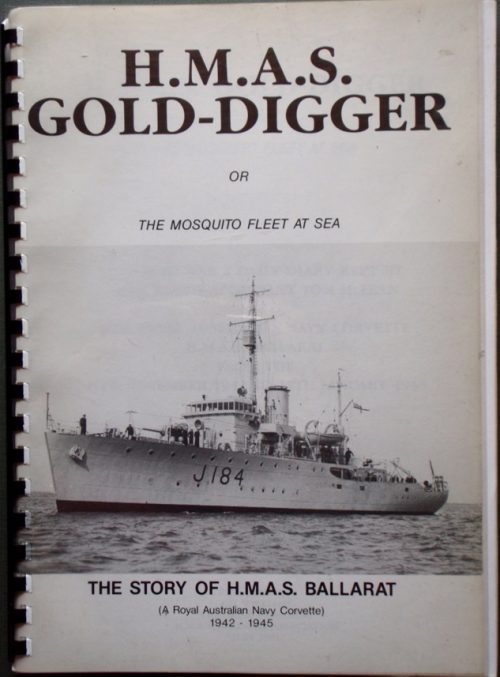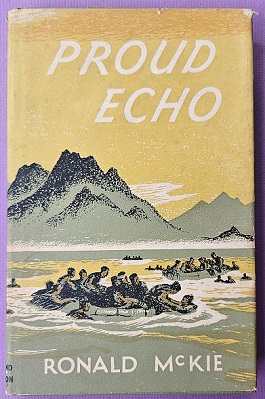Description
Title: H.M.A.S Gold-Digger – The Story of HMAS Ballarat or the Mosquito Fleet at Sea (A Royal Australian Navy Corvette 1942 – 1945 (2 Volume Set)
Author: McLean, Tom
Condition: Very Good
Edition: 1st Edition
Publication Date: 1991 – Volume 1, 1995 – Volume 2
ISBN: 0646254685
Cover: Soft Cover without Dust Jacket – 159 pages (Volume 1), 696 pages (Volume 2) (Both volumes spiral bound)
Comments: The detailed history of HMAS Ballarat during World War 2. Includes the wartime diary of the author who served as a sickbay attendant on HMAS Ballarat.
Now a extremely rare and highly desirable Royal Australian Navy ship history book.
HMAS Ballarat (J184), named for the city of Ballarat, Victoria, was one of 60 Bathurst class corvettes constructed during World War II and one of 20 built for the Admiralty but manned by personnel of and commissioned into the Royal Australian Navy (RAN).
Ballarat was laid down by HMA Naval Dockyard in Williamstown, Victoria, on 19 April 1940. She was launched on 10 December 1940 by the wife of Albert Dunstan, then Premier of Victoria, and commissioned into the RAN on 30 August 1941.
Ballarat entered service on 20 September 1941, and on her arrival in Sydney three days later was immediately assigned to the 20th Minesweeping Flotilla. On 1 November, she was given the duty of providing anti-submarine protection to converted ocean liner Queen Mary, prior to her departure as part of a troop convoy to the Middle East. Ballarat departed for Darwin on 14 November, towing an oil lighter. On her arrival on 8 December, the corvette began escort patrols between Darwin and Timor. She headed to Singapore in early 1942, then was assigned to Banka Strait, where she was employed in rescue and demolitions work. On 14 February, Ballarat carried out one of the largest rescue operations in the region, collecting 215 survivors from the torpedoed merchant vessel MV Derrymore. Amongst the survivors was John Gorton, who would later become Prime Minister of Australia. Ballarat was also involved in the evacuation of Sumatra, and was the last RAN ship to leave.
On the conclusion of this assignment, the corvette returned to Australian waters and resumed convoy operation between Australia and New Guinea. In November 1942, Ballarat and sister ship Katoomba were attacked by Japanese dive bombers. In December 1942, Ballarat and sister ships Broome and Colac were involved in the deployment of troops to Buna; Ballarat performing four troop deployments over the month.
The corvette was ordered to the east coast of Australia in April 1943, to counter the increasing Japanese submarine threat. She remained in this role until January 1944, when she returned to Darwin to perform patrols to Thursday Island. Ballarat was again used as a troop transport in August 1944, moving soldiers from the Eilanden River in Papua New Guinea to Merauke, Indonesia. In 1945 she returned to Sydney to perform minesweeping operations prior to the arrival of the British Pacific Fleet, and then participated in the invasion of Okinawa.
Ballarat was present in Tokyo Bay on Victory over Japan Day (2 September 1945), when the Japanese Instrument of Surrender was signed. She was then deployed on minesweeping duties in the Hong Kong area, during which she struck a mine on 6 November 1945. She returned to Melbourne on 13 December, and was decommissioned into reserve on 27 September 1946. Ballarat’s wartime service was recognised by three battle honours: “Pacific 1941-45”, “New Guinea 1942-44”, and “Okinawa 1945”.
Ballarat was sold on 10 July 1947 to China Traders Ltd of Hong Kong, who then sold her on to the Ta Hing Company (Hong Kong) Ltd in December 1950. Refitted as a coastal trader and renamed Carmencita, the corvette never entered civilian service as a Statutory Order issued by the Australian Government prevented the ship from entering Chinese waters. Instead, she was sold a third time to John Manners and Co (Aust) Pty Ltd in 1953, who broke the ship up for scrap in the same year.




